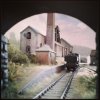Chris Nevard
Western Thunderer
It's this stuff here http://www.craftycomputerpaper.co.uk/.Inkjet-Water-Slide-Decal-Paper_151.htm
I've only just started to play about, but for unfitted stock where you have white lettering in a black box it's easy peasy. We only have a cheapo but new printer, but the quality is outstanding.
I knocked up the graphics in Photoshop, and then inserted the file into a Word Doc for resizing, running off test prints onto ordinary paper until I got the size I wanted.
For white lettering on fittted stock you'd need white printer ink, I've not tried that.
I've only just started to play about, but for unfitted stock where you have white lettering in a black box it's easy peasy. We only have a cheapo but new printer, but the quality is outstanding.
I knocked up the graphics in Photoshop, and then inserted the file into a Word Doc for resizing, running off test prints onto ordinary paper until I got the size I wanted.
For white lettering on fittted stock you'd need white printer ink, I've not tried that.

 no more wonky wagon lettering
no more wonky wagon lettering 








 ........you have my deepest sympathy's
........you have my deepest sympathy's


 ).
).